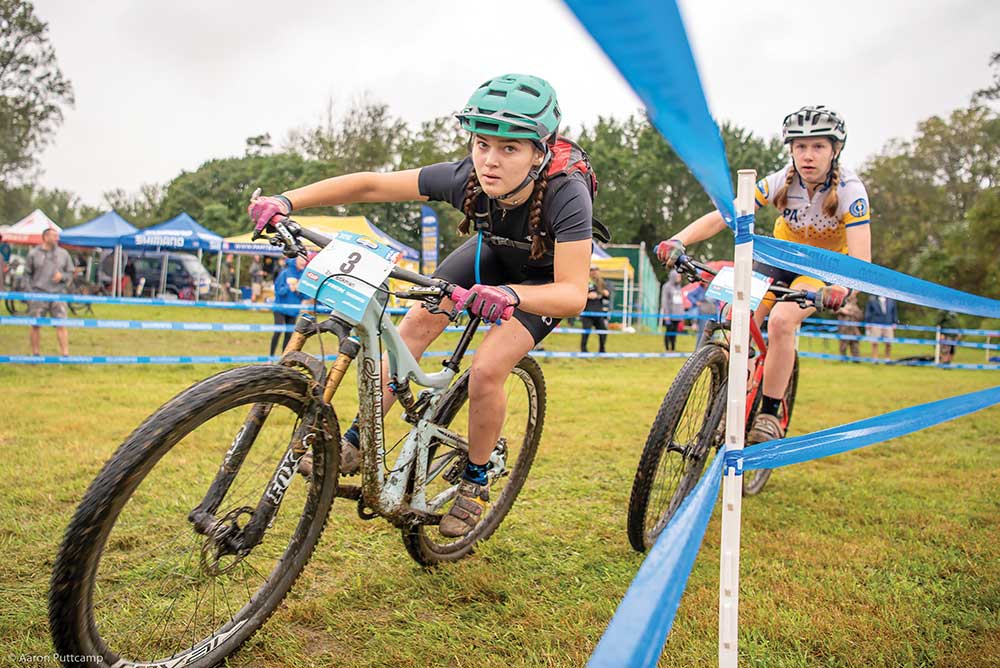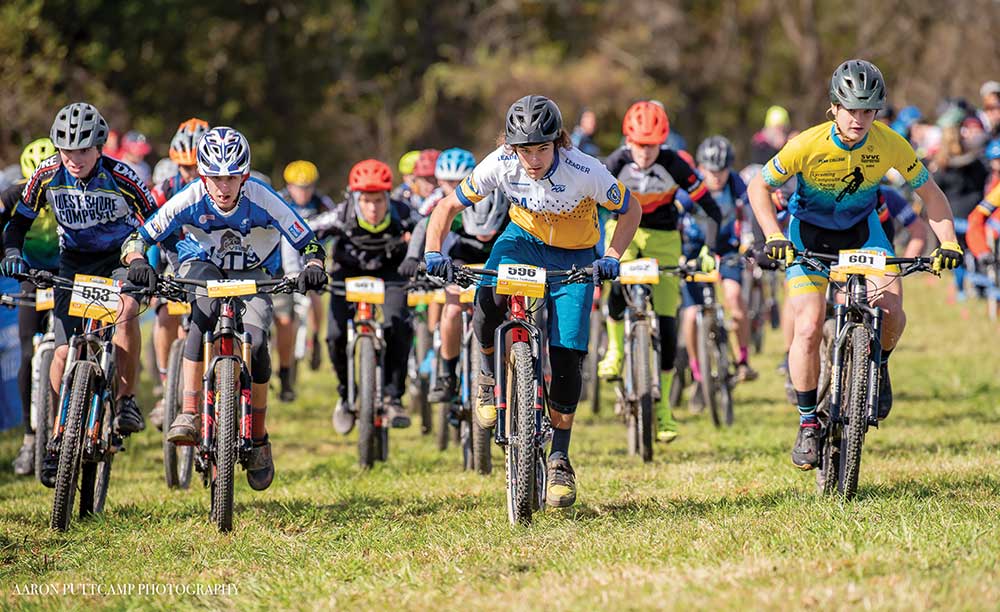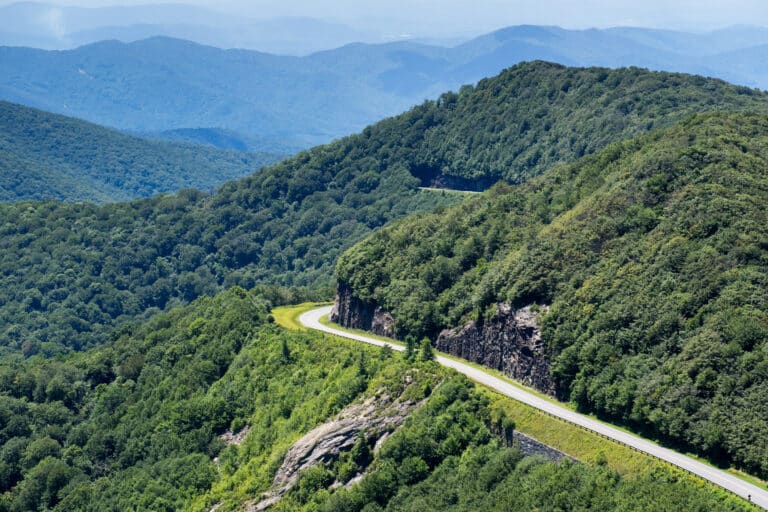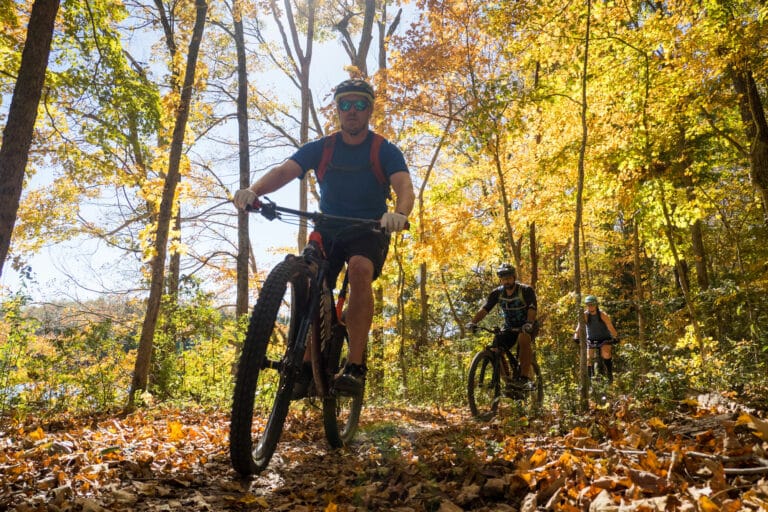Riders in the Pennsylvania league head out on the trail. Photo by Aaron Puttcamp
High school biking is big in the Blue Ridge. Here’s why.
Before the National Interscholastic Cycling Association (NICA) was officially founded in 2009, you’d be hard-pressed to find mountain biking in middle and high schools across the country.
A school here or there might have a club formed by a few dedicated students. Otherwise, you’d have to look into highly specialized schools or compete in your free time if mountain biking was your sport.
In the last ten years, NICA has added 27 leagues in 26 states with plans for more in the future. But even though the league has been growing, at a rate of about 40 percent a year, NICA is not a common acronym that rolls off of the tongue.
“Outside of the cycling industry, still not many folks have heard about us,” said parent Kristine Urrutia. “If you say Girls on the Run, people know Girls on the Run. Their numbers are larger than ours. But I do feel like at some point we’re going to break that ceiling, and everybody is going to know what NICA is.”
Kenny Griffin, the Georgia league director, has seen the sport explode since Georgia became the ninth league to launch in 2013.
“The first year, we started with 121 high school student-athletes, 50 coaches, and 10 teams,” he said. “In year two, we expanded our programming to middle school student-athletes as well. This year, we’re expecting 1,200 student-athletes, 750 coaches, and 74 teams across the state of Georgia. So, in six years, it’s been an explosive rocket that we’re all riding.”
As the organization works to reach more kids, league directors and coaches are addressing issues of accessibility within the sport. Through private donations, sponsorships, and grants, leagues are able to provide financial aid and loaner bikes to students who demonstrate need.
“If we want to reach more kids, we want the barrier to entry to be as low as possible,” Griffin said. “We don’t want to make it $5,000 per kid to join because we would probably cap out at 200 kids because not very many kids can afford to join a $5,000 sport.”
Teams also have to work on finding a place to practice.
“In order to have a team, you gotta have a trail system,” Griffin said. “Arguably, the reason Georgia has been so successful is because the timing of our league being created and the evolution of trail infrastructure have been very cohesive. Without that, we wouldn’t have been able to be as successful as we are. We do find some scenarios where there are no trails for kids to practice. We have a model that works on a soccer field or grassy open area where you can build fitness and teach skills. But we’re very lucky to have good support from land management and local governments for new trails.”
A NICA season is comprised of four or five-weekend race events in the fall or spring depending on the state. Mike Kuhn, director of the Pennsylvania League, said the organization intentionally did not want it to be a year-round sport.

“We absolutely want all of our student-athletes to go do other stuff, whether it’s other sports, academic clubs, work,” he said. “All around athletic development is showing to be potentially more effective because it reduces burnout and there’s less likelihood for injury.”
The Coaches
The key to the NICA model is the coaches. The organization strives to have no more than four student athletes per coach. And as the number of students participating continues to rise, so is the number of coaches involved.
Kuhn said NICA is not so much a mountain bike racing organization as it is a youth development program.
“In the real world, intervals aren’t making you a better person,” he said. “Competition itself doesn’t make you a better person. The interactions that you have with all of the people around that process, how you build community, camaraderie, and connectivity, that’s what matters. So, we want to be very deliberate about that. A big piece of this is coaching. We do ask a lot of our coaches. I think the coaches get as much out of it as the students do.”
Every coach goes through NICA training, including risk management, on-the-bike skills, and coaching philosophy.
“You have to understand how to identify trails that are appropriate for the wide range of student-athletes,” Kuhn said. “We have really elite-level competitors down to student-athletes who may be four or five rides into mountain biking. The first ride they did at practice was how to get on and off the bike properly. So, we want them to have a good time, and we want our elite racers to have a good time. It means that maybe a course isn’t as East Coast technical as it might otherwise be, but it can still be twisty and feature good singletrack and all of the things that still make for a fun experience.”
Alaina Dietz is heading into her fourth year of coaching the Keystone Composite team in Pennsylvania.
“Interesting thing about our team, it was started by three women, none of which have children on the team,” she said. “We have coaches that are just passionate about mountain biking and sharing their sport with you. And have the time resources and financial resources to be able to share that.”
Dietz started advocating for more women and kids in the sport after years of racing, including a national cross-country championship. When she heard a NICA league was coming to Pennsylvania, she knew she wanted in.
“We thought maybe we’d get five kids in our first year,” she said. “We’d be super stoked to make our little team and see what happened. In our first year, we had 30 kids come out to the team. So, then we had to recruit all of these other adults to help us. Now the team is in its fourth year. We’re well into the 40s and probably 20 coaches that help out with the team.”
With mountain biking, coaches aren’t on the sidelines with a whistle. They are riding with the kids, moving and engaging through the sport.
“A lot of our coaches are parents who are mountain bikers who are like, yes, my kid rides,” Dietz said. “This is wonderful. I can now ride trails with my daughter. This is a dream come true. We even have some parents who weren’t mountain bikers but gave it a try and have become good cyclists in the meantime. So, we have parents who come in and learn with their children. It’s cool to see a whole family evolve in the sport.”
In the last two seasons, the Pennsylvania league has tested two pilot programs for NICA, Adventure Programming, and Teen Trail Corps.
“We know that there are a bunch of students out there who may not be driven by competition,” Kuhn said. “We just want to get them engaged, riding, and stoked about it. Once they try it, maybe they’ll like doing some gravel, bike packing, enduro, or cyclocross. It’s not really about just being a mountain biker. It’s finding out about cycling and see where it takes you. We hope it’s something that you enjoy so much you’re going to do it some way, shape, or form for life. Whatever that might be for you is great.”
The Adventure Programming allows students to still participate with the team, including practices and weekend events, without the pressure of racing. Students can also get involved with maintaining local trails and advocating for new ones.
“Many years ago, Pennsylvania mountain bikers lost access to about 1.5 million acres of state game lands,” Kuhn said. “With that legacy and history, we want to be clear that this is super important to us. I don’t separate riding a mountain bike from trail stewardship. To me, it’s all-mountain biking. If you’re riding, you’re raking.”
Pennsylvania decided to make stewardship an integral part of the season scoring. Teams can earn half of their points for the team championships by reporting their trail work hours.
“Mountain biking is a privilege,” Dietz said. “It’s not a right to go and ride public lands. We can advocate to have better land access to keep our trails and help our sport.”
However a student chooses to get involved, whether it’s racing or helping out as the team mechanic, there is a place for them in mountain biking.
“I feel that giving kids a healthy outlet for adventure is super valuable, especially in an age where kids who don’t have a healthy outlet for adventure may go and seek that in other not so healthy ways,” Dietz said. “So many parents saw significant changes in their children in other areas of life. Their kids had better attitudes at home. Their kids had a better attitude about school. Their kids just had an overall better sense of well-being once they found a sport that they really connected with. I think there’s something magical about being on a bike, moving, balancing, riding through the trails, seeing great scenery, sweating, and getting dirty that makes this sport a little bit different than other sports.”
The Students
As she’s waiting on her bike at the start line, Juliet Breit can feel the adrenaline start to kick in.
“It’s really nerve-wracking because you’re at the line and you’ll see all of the grades before you go,” Breit said. “They call out 30 seconds and then you start with this really loud buzzer. You’re so nervous the first couple minutes of the race. But then once you actually get into the race, you really get into the flow of it. You don’t see that many other girls on the course with you, even though they’re all out there. You get to go at your own speed. I love racing with the other girls because every time I’ll pass somebody, we’ll encourage each other to keep it up and stuff like that.”
Heading into her sophomore year, Breit is gearing up for her fourth season racing with NICA. She got hooked in seventh grade when a few parents started a team at her middle school.
Breit, 15, was drawn to sports like cross country and powerlifting that had more of an individual component. While she had ridden her bike around town with her family, she had never tried mountain biking before.
“I was really nervous going into it,” Breit said. “None of my friends were doing it. The first race I was really nervous. But the rest of the races, I got less nervous and more excited for them. I just really liked the experience of them. And then, of course, we grew as a team and bonded together. But it was hard being one of two girls out of a team of 20.”
Although Breit really enjoyed the sport, her new high school did not have a mountain biking team. So, her dad decided to start one.
“I love having my dad there because it feels like he can understand me,” Breit said. “It’s nice having somebody who you know really closely be in the sport with you, come to all of your races, and support you in that way.”
The NICA model offers flexibility for students and coaches. Depending on the number of kids interested, the team can be based around a specific school, like other traditional sports, or can be a composite team made up of students from all over the area.
“School-based teams means sustainability because you have school pride,” Griffin said. “It’s associated with an administration, so you get announcements, a trophy in the trophy case, parents are involved, varsity kids letter, your team is on the school website as an endorsed activity. Some schools even provide bus transportation and coach stipends.”
With a composite team, the practices can be tough when everyone has a different school schedule and can’t get out to the trails during the week. They’ll do skill work at local parks during the week and then travel to trails on the weekends. But when a team is first starting out, it’s a great way to get kids excited in hopes that they will recruit more riders.
The races are big events, with pre-rides on Saturday and the races on Sunday. Breit said she’s worked out a system where she’ll ride the course a few times on Saturday to get a feel for the trail.
“Maybe one time I ride it slower,” she said. “The next time I’ll try to push myself more and see what pace I’ll go at.”
Last year, Breit also participated in NICA’s new program, Girls Riding Together (GRiT).
“As a female rider, it’s hard because there are so many more male riders,” she said. “The environment is more focused towards them in some ways. But on Saturday, we [GRiT] get together, hang out, focus on skills, and do a pre-ride together. It was just such a great part of the season for me because I feel like it really boosted my confidence and made me feel more comfortable in a sport that has more male riders. A couple of seasons ago, I only had three girls racing against me. There were 30 or 40 boys. Having that program has helped me and it’s created a stronger bond between racers.”
She hopes this program will help encourage other female riders to get out on a bike.
“It’s hard to get girls into it,” Breit said. “Whenever I tell my friends to join, they think of it as doing flips off of rocks on your bike. But that’s really not what it’s about. It’s more trail riding. So, I think getting girls into it and having them see how much fun it is, is a key part of the program. It doesn’t matter how big your team is or how good you are at the sport, just enjoy it. It’s a great way to just be outside in the environment, but also still riding with your teammates.”
The Parents
Before her three kids joined their local NICA team, Kristine Urrutia was not a mountain biker.
“I didn’t know how to mountain bike and I wasn’t interested in mountain biking,” she said.
Although she was a triathlete and did some road cycling, she would run behind her kids when her husband took them mountain biking. That is, until he got her a mountain bike for Mother’s Day.
“He was like no longer are you going to run behind us,” Urrutia said. “You’re going to learn to ride. The family is moving the needle on me. You really need to learn how to mountain bike, mom. That was roughly four or five years ago, and I started mountain biking at 44 years old.”
In addition to getting on the bike herself, Urrutia has seen all three of her kids excel in various ways through mountain biking and competing with NICA.
Her middle son, who was born with global low muscle tone, was in various forms of physical, occupational, and speech therapy for most of his life.
“Mountain biking, in so many ways, has changed him completely, being a part of a team,” Urrutia said. “I took him to therapy one day and his physical therapist told me to stop bringing him. You’re doing all he needs with his mountain biking. All of his synapses that need to be firing are firing. Joining NICA and being a part of the cycling community has just opened up his world and built his confidence.”
With the success she saw with her own kids, it didn’t take Urrutia long to get involved with the organization at the state and national level.
“I drank the Kool Aid about the idea,” she said. “It had a mix of everything I loved. It was kids getting exercise and kids being outdoors in the woods.”
As part of the management team, Urrutia is helping connect with more partners and raise funds for NICA.
“We’re at the point now where our growth is sort of exceeding our capacity as an organization,” she said. “But that’s a good problem for us to have.”
All of this, Urrutia said, is part of the push to create the next generation of lifelong cyclists.
“We don’t want this to be a one and done sport,” she said. “Like where you were the great football or soccer player in high school, and then as you went into your adult life, you weren’t playing those sports anymore. We look at this as something that someone can do for the rest of their life.”
Classes Near You
Check out these groups around the region for workshops and group rides geared towards getting more people out on the trails.
Roanoke Mountain Adventures (Roanoke, VA): Learn the skills you need on the trail with a public or private class. Equipment provided. Once you’ve got the basics, tour this IMBA Silver-Level Ride Center with guides who will customize a trip for your skill level.
CLIMB Works Smoky Mountains (Gatlinburg, TN): Take a tour through the Smokies on an e-bike, a mountain bike with electric pedal-assist. They will guide you through the first loop and set you on your way for an adventure.
Bearings Bike Shop (Atlanta, Ga.): This community bike shop allows kids to earn their bike as they work and complete tasks in the shop. Along the way, they pick up mechanical and critical thinking skills to prepare them for life.
Spoke’n Revolutions (Carrboro, NC): Youth can hit the road on a multi-day bike packing experience with a focus on history and environmental destinations.
Take Aim Cycling (Shenandoah Valley, VA): From beginners to pros, the Shenandoah Valley to Massanutten Bike Park, individuals to groups, these instructors will help you fine-tune your skills for the trails.
Arrowhead Bike Farm (Fayetteville, WV): Rent a bike or bring your own for a mountain bike clinic right in the mountains of West Virginia and the New River Gorge.







